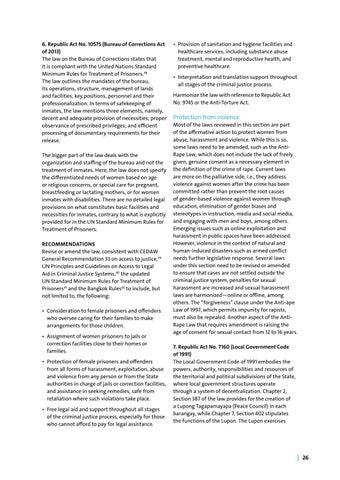6. Republic Act No. 10575 (Bureau of Corrections Act of 2013) The law on the Bureau of Corrections states that it is compliant with the United Nations Standard Minimum Rules for Treatment of Prisoners.38 The law outlines the mandates of the bureau, its operations, structure, management of lands and facilities, key positions, personnel and their professionalization. In terms of safekeeping of inmates, the law mentions three elements, namely, decent and adequate provision of necessities; proper observance of prescribed privileges; and efficient processing of documentary requirements for their release. The bigger part of the law deals with the organization and staffing of the bureau and not the treatment of inmates. Here, the law does not specify the differentiated needs of women based on age or religious concerns, or special care for pregnant, breastfeeding or lactating mothers, or for women inmates with disabilities. There are no detailed legal provisions on what constitutes basic facilities and necessities for inmates, contrary to what is explicitly provided for in the UN Standard Minimum Rules for Treatment of Prisoners. RECOMMENDATIONS Revise or amend the law, consistent with CEDAW General Recommendation 33 on access to justice,39 UN Principles and Guidelines on Access to Legal Aid in Criminal Justice Systems,40 the updated UN Standard Minimum Rules for Treatment of Prisoners41 and the Bangkok Rules42 to include, but not limited to, the following: • Consideration to female prisoners and offenders who oversee caring for their families to make arrangements for those children. • Assignment of women prisoners to jails or correction facilities close to their homes or families. • Protection of female prisoners and offenders from all forms of harassment, exploitation, abuse and violence from any person or from the State authorities in charge of jails or correction facilities, and assistance in seeking remedies, safe from retaliation where such violations take place. • Free legal aid and support throughout all stages of the criminal justice process, especially for those who cannot afford to pay for legal assistance.
• Provision of sanitation and hygiene facilities and healthcare services, including substance abuse treatment, mental and reproductive health, and preventive healthcare. • Interpretation and translation support throughout all stages of the criminal justice process. Harmonize the law with reference to Republic Act No. 9745 or the Anti-Torture Act.
Protection from violence Most of the laws reviewed in this section are part of the affirmative action to protect women from abuse, harassment and violence. While this is so, some laws need to be amended, such as the AntiRape Law, which does not include the lack of freely given, genuine consent as a necessary element in the definition of the crime of rape. Current laws are more on the palliative side, i.e., they address violence against women after the crime has been committed rather than prevent the root causes of gender-based violence against women through education, elimination of gender biases and stereotypes in instruction, media and social media, and engaging with men and boys, among others. Emerging issues such as online exploitation and harassment in public spaces have been addressed. However, violence in the context of natural and human-induced disasters such as armed conflict needs further legislative response. Several laws under this section need to be revised or amended to ensure that cases are not settled outside the criminal justice system, penalties for sexual harassment are increased and sexual harassment laws are harmonized—online or offline, among others. The “forgiveness” clause under the Anti-ape Law of 1997, which permits impunity for rapists, must also be repealed. Another aspect of the AntiRape Law that requires amendment is raising the age of consent for sexual contact from 12 to 16 years. 7. Republic Act No. 7160 (Local Government Code of 1991) The Local Government Code of 1991 embodies the powers, authority, responsibilities and resources of the territorial and political subdivisions of the State, where local government structures operate through a system of decentralization. Chapter 2, Section 387 of the law provides for the creation of a Lupong Tagapamayapa (Peace Council) in each barangay, while Chapter 7, Section 402 stipulates the functions of the Lupon. The Lupon exercises
| 26

